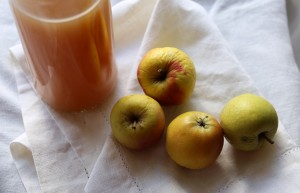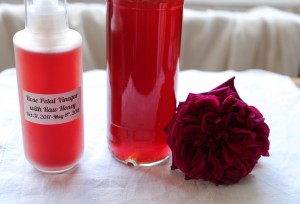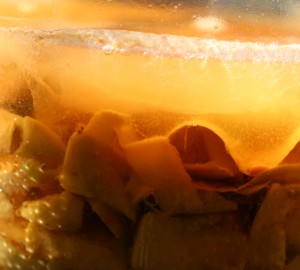In eastern Australia spring and early summer with their explosive plant growth are great seasons for making ferments from vegetables and flowers, while in autumn and winter it is mainly fruit that is fermented. In times of abundance I love to make various vinegars for cosmetic and culinary use, and also for cleaning and gardening.
Making own vinegars utilises fruit scraps and of flowers and gives you the satisfaction of having your own household cleaning aids instead of the store-bought ones. And the luscious, deep red rose petal vinegar is my skin toner of choice!
Now, the practical part – recipes!
Cleaning Vinegars
 Before you put vegetable scraps (peels, apple cores, banana skins, cuttings etc) into compost, you can use them first to make cleaning and garden vinegars (also known as Eco Enzymes*, Garbage Enzymes*).
Before you put vegetable scraps (peels, apple cores, banana skins, cuttings etc) into compost, you can use them first to make cleaning and garden vinegars (also known as Eco Enzymes*, Garbage Enzymes*).
They are made from fresh fruit and vegetable scraps. Avoid using decomposing materials – what you want is to start the process of sugar fermentation which leads to the creation of acetic acid, the main component of vinegars. It happens when you mix fresh plant waste with sugar and water. The wild bacteria present in the environment will ferment the vegetable/fruit sugars from scraps and the added sugar and convert them into alcohol and vinegar. It takes about 3 months for all sugars to be used up and become the acid.
Ingredients:
- 300 g of fresh fruit and vegetable scraps
- 100 g of sugar (brown sugar, rapadura, molasses)
- 1 litre of water (preferably rainwater; if using tapwater, leave it overnight in an open bucket or boil and cool before using)
- A plastic bucket with a tight-fitting lid (for example, a 2L yoghurt bucket).
Method:
- Dissolve the sugar in lukewarm water.
- Put the scraps in the bucket and cover with the prepared sweetened water
- Close the lid tightly.
- In the first month open and stir every day. The pressure will build up in the bucket (particularly in warm weather) and needs to be released. This is also why flexible vessel needs to be used – a glass jar can shatter under pressure.
- For the next two months stir occasionally. You will see a film of yeast and bacterial blooms showing on the surface. This is normal and as the mixture becomes more acidic, these cultures will die.
- After three months in the bucket, strain/filter the liquid into plastic bottles for storage and compost the solids.
Undiluted or slightly diluted the vinegar is an excellent all-purpose cleaner, which can be kept in a spray bottle in the kitchen or bathroom.
Use diluted in the garden (1 teaspoon per 1 L of water) to introduce bacteria to the soil and as a foliar spray to discourage pests and prevent white mildew in cucurbits.
Cosmetic Rose Petal Vinegar
 Use the same method as above, but instead of fruit and vegetable scraps use fresh rose petals. Sugar can be substituted with raw honey.
Use the same method as above, but instead of fruit and vegetable scraps use fresh rose petals. Sugar can be substituted with raw honey.
You will have the best result with deep red roses with a true rose fragrance. I grow a Munsted Wood rose (pictured) which flowers 3-4 times a year and produces up to 200 fragrant flowers in the spring flowering and between 120-150 in each of the next ones.
Store the finished vinegar in small spray or pump bottles and use after washing your face to restore the natural, slightly acidic skin pH.
Apple Cider Vinegar
 Every time I make a batch of apple sauce, I put apple peels and cores aside to ferment them into an apple cider vinegar. You could do this with pears, too.
Every time I make a batch of apple sauce, I put apple peels and cores aside to ferment them into an apple cider vinegar. You could do this with pears, too.
This year I had a great success with wild apples I foraged in Autumn. They were small but very aromatic and made great preserves and ACV!
Ingredients:
- 1 kg of apple cores and peels
- 1.5 L of boiled water cooled to lukewarm
- 2.5 tablespoons of sugar (doesn’t matter what type as it will be completely fermented into acetic acid, but I prefer rapadura)
- 3 L glass jar or fermenting crock, sterilised with boiling water
- piece of muslin and a rubber band
…or instead of sugar you can use wood (or birch) sugar – xylitol:
- 1 kg of apple cores and peels
- 1 L of boiled and cooled water
- 5 tablespoons of xylitol
- 3 L glass jar or fermenting crock, sterilised with boiling water
- piece of muslin and a rubber band
Method:
- Put all apple cores and peels into the jar/crock.
- Dissolve sugar in lukewarm water and pour over the apple scraps. They should be completely covered.
- Weight the scraps down with a fermenting weight or a small plate, so all pieces are submerged.
- Cover the vessel with twice folded muslin or other loosely woven fabric and secure with a rubber band to protect the ferment from insects.
- Keep away from direct sunlight.
- In the first week you need to stir the contents, but do not forget to put the weight back in.
- Depending on temperature, the vinegar will be ready in 2-5 weeks.
- Strain through a sieve and muslin into bottles, close them for storage and use the vinegar as you normally would.
————————————
*/ these ferments are misleadingly called “Eco Enzymes” or “Garbage Enzymes” and are promoted as miraculous treatments for everything from cleaning kitchens to clearing polluted waters. However, natural plant enzymes cannot survive the acidic environment which is the result of fermenting fresh plant scraps with sugar. And only a few plants (like green papaya) have the concentration of enzymes in fresh fruit high enough to have practical applications.



Hi Margaret, my husband eats and orange a day and I’d like to make a citrus cleaner. Would I use the same recipe as the apple or vegetable scraps. Thank you for your continual sharing of your knowledge and skills, it’s very encouraging to live differently. Thanks Sam
Hi Sam, a good idea is to keep the orange peels in a freezer until you have at least 300 g of them (which will make a litre of the cleaner). Good luck!
I like your openness in your guidance. Thanks. Unlike the you tube videos showing how drinkable fruit enzymes are made which doesn’t quite explain, your note on garbage enzymes is refreshing.
Would you be able to help me with the following ? I recently harvested my pomegranates.
1. I used the skins to make the garden garbage enzymes. I misplaced the cover of my bucket in the house move. Can I cover the bucket using glad wraps, then secure the top with a saucepan cover that fits? It’s not airtight, but covers properly like the saucepan.
2. I juiced the pomegranate. I layer the left over pulp (still moist) with lemon, ginger, pineapple and raw honey/manuka honey to make the drinkable fruit enzymes yesterday. Hope this works!! I swirl it around the next day and saw the emerging liquid.
I can’t wait to gather sufficient materials to make my own rose petal toners and acv!! How liberating!! They don’t have a shelf life, do they?